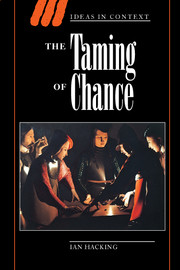Book contents
- Frontmatter
- Contents
- Acknowledgements
- 1 The argument
- 2 The doctrine of necessity
- 3 Public amateurs, secret bureaucrats
- 4 Bureaux
- 5 The sweet despotism of reason
- 6 The quantum of sickness
- 7 The granary of science
- 8 Suicide is a kind of madness
- 9 The experimental basis of the philosophy of legislation
- 10 Facts without authenticity, without detail, without control, and without value
- 11 By what majority?
- 12 The law of large numbers
- 13 Regimental chests
- 14 Society prepares the crimes
- 15 The astronomical conception of society
- 16 The mineralogical conception of society
- 17 The most ancient nobility
- 18 Cassirer's thesis
- 19 The normal state
- 20 As real as cosmic forces
- 21 The autonomy of statistical law
- 22 A chapter from Prussian statistics
- 23 A universe of chance
- Notes
- Index
- Ideas in Context
7 - The granary of science
Published online by Cambridge University Press: 05 June 2014
- Frontmatter
- Contents
- Acknowledgements
- 1 The argument
- 2 The doctrine of necessity
- 3 Public amateurs, secret bureaucrats
- 4 Bureaux
- 5 The sweet despotism of reason
- 6 The quantum of sickness
- 7 The granary of science
- 8 Suicide is a kind of madness
- 9 The experimental basis of the philosophy of legislation
- 10 Facts without authenticity, without detail, without control, and without value
- 11 By what majority?
- 12 The law of large numbers
- 13 Regimental chests
- 14 Society prepares the crimes
- 15 The astronomical conception of society
- 16 The mineralogical conception of society
- 17 The most ancient nobility
- 18 Cassirer's thesis
- 19 The normal state
- 20 As real as cosmic forces
- 21 The autonomy of statistical law
- 22 A chapter from Prussian statistics
- 23 A universe of chance
- Notes
- Index
- Ideas in Context
Summary
London, 22 February 1832 Amongst those works of science which are too large and too laborious for individual efforts, and are therefore fit objects to be undertaken by united academies, I wish to point out one which seems eminently necessary at the present time, and which would be of the greatest advantage to all classes of the scientific world.
I would propose that its title should be ‘The Constants of Nature and of Art’. It ought to contain all those facts which can be expressed by numbers in the various sciences and arts.
Numerical regularities about disease, unknown in 1820, were commonplace by 1840. They were called laws, laws of the human body and its ailments. Similar statistical laws were gaining a hold over the human soul. The analogy was close, for laws of behaviour aimed at sick souls. Medical men were able to claim new expertise in matters moral and mental. Before proceeding, however, we should briefly ask an elementary question: what does a law of nature look like?
Our most familiar law is still Newton's. It says that the force of gravitational attraction between two bodies is equal to the product of their masses divided by the square of the distance between them — all multiplied by the gravitational constant. Newton did not write it that way, for he expressed his analysis in terms of ratios, so that the constant that we call ‘G’ is invisible. His work did imply a value for G. A 1740 French expedition to Mt Chimborazo in Ecuador made a fair experimental determination of it, but the observers thought of themselves as determining the mass of the earth.
Information
- Type
- Chapter
- Information
- The Taming of Chance , pp. 55 - 63Publisher: Cambridge University PressPrint publication year: 1990
